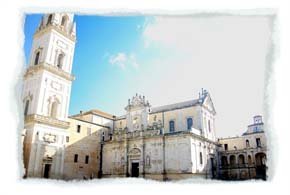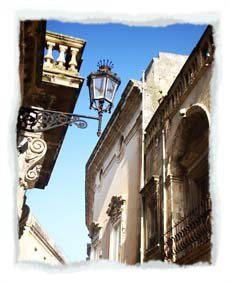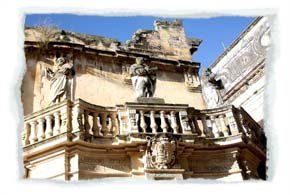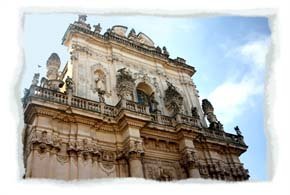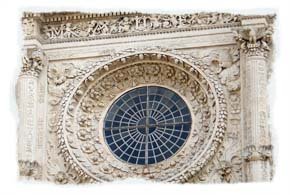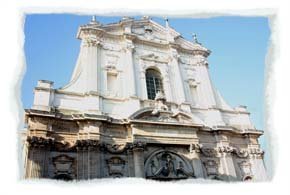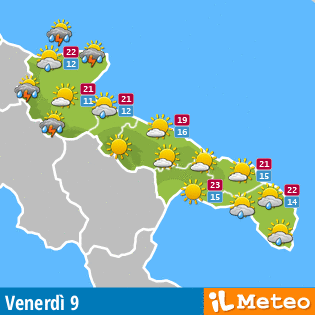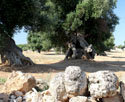Lecce
Info Lecce
-
Region:
Provincie:
Municipality:
CAP:
Area code:
Surface:
Population:
city hall:
-
Apulia
Lecce
Lecce
73100
0832
238,39 Kmq
89.598
Via Rubichi 16
Lecce, the city of Baroque
Lecce, the city of Baroque, is famous all over the world thanks to its really valuable Baroque which is its distinguishing mark; its splendour is due to the intuition of emperor Carlo V, who provided the city with new defensive structures against the Turks and promoted the artistic development which made the city win the name Firenze del Sud (“the Florence of southern Italy”). Since 1630, indeed, the city has been deeply renewed according to the new Baroque taste, becoming a real building yard.
Originally Lecce was a Messapic town, founded as suburb of the ancient Rudiae; after the Roman conquest, in the 3rd century B.C., it took the name Lupiae becoming a “municipium”. At that time the city experienced a period of great magnificence with emperor Marco Aurelio. With Normans it became the chief town of the Salento, being the most important trading and politic centre in the whole area. Here was born Tancredi, the last Norman king, son of Ruggero III. The old town centre is full of beautiful Baroque buildings but, notwithstanding this, it shows its medieval structure with streets, arches, courtyards, squares, palaces and churches.
The heart of the city is represented by the square dedicated to Sant’Oronzo, characterized by a Roman elliptical Amphitheatre excavated in the calcareous rock,count in the 2nd century B.C.; it could accommodate 20.000 people. Here it is possible to admire also the Palazzo del Sedile, with its 16th - century arcade, which was the seat of the municipal authorities, and the column of Sant’Oronzo, patron saint of the town. The column comes from Brindisi, where, with a second column, marked the end of the Appian way. Symbol of the civil power is the castle of Carlo V, who conformed the Norman castle, built by count Tancredi, to the new defensive requirements commissioning the work to the architect Gian Giacomo dell’Acaja, who realized it between 1539 and 1549.
In opposition to the lay square dedicated to Sant’Oronzo, we find the magnificent square of the Cathedral: it is one of the most beautiful and elegant places in the town. The square appears as a stage for the Cathedral, the Bishop’s palace and the Seminary, which represent some of the most significant Baroque expressions in Lecce. The Cathedral was built in 1114 with a Romanesque structure and has been completely renovated between 1659 and 1670 by Giuseppe Zimbalo. In order to confer the right perspective to the square, the spectacular side entrance was built being the first façade we see entering the square. At the end of the square, stands the Bishop’s palace, built in the 16th century and renovated many times until the last reorganization realized by Emanuele Manieri, during the 18th century. The palace of the Seminary was built by Giuseppe Cino between the end of the 17th century and the beginning of the 18th century; it shows a rich ashlar façade with two orders of windows framed by decorations and a central balcony with an elegant arcade.
The most beautiful church in Lecce is the Basilica di Santa Croce: it was realized according to the plan of Gabriele Riccardi, starting from 1549, and it is the main symbol of the Baroque of Lecce all over the world. The building works lasted more than a century and involved important architects such as Antonio Zimbalo and Cesare Penna. The façade is dominated by its rose window with concentric lintels, flowers and putti, held by a garland borne by some angels. The façade is divided into two orders by an elegant balustrade and it is full of putti, grotesque, symbolic and zoomorphic figures. Inside the church is large and bright; we find three naves divided by columns which date back to the first building phase. Great decorative magnificence can be admired in the chapels altars, in the capitals and in the valuable carved wooden gold ceiling, which covers the central nave; it has been realized during the first half of the 17th century.

